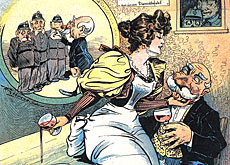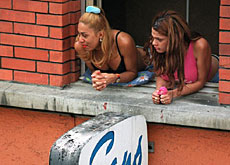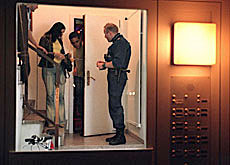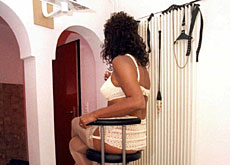Exhibition looks back at prostitution in Zurich

Switzerland’s first exhibition devoted to the world’s oldest profession looks back to a time when prostitution thrived in Zurich.
Covering 1875 to 1925, it tells in graphic detail the story of an often sordid aspect of the Belle Epoque, when it was considered normal for well-to-do men to visit brothels.
A tour of the exhibition at the Bärengasse Museum begins in a dimly-lit salon with comfortable and elegant furnishings typical of the period and with an aura of respectability.
Photographs of some of the more glamorous prostitutes and their clients adorn the walls, while television screens feature early 20th century films of men and women sitting and laughing together as if it were a conventional, middle-class social gathering.
But as the exhibition later shows, beneath the surface of these happy scenes lurked a life of misery for the women, many of whom were still in their teens and from poor families in the countryside around Zurich.
Venereal disease was a common hazard, especially for the usually older women operating on the streets of Zurich.
Another was a growing backlash by churches and social reformers, which could lead to the sex workers’ imprisonment or confinement in psychiatric clinics.
This opposition eventually led to the official closure of brothels by the Zurich authorities in 1898.
Ban on brothels
Of course this ban didn’t put a stop to the trade in flesh. In accordance with the prevailing double standards, prostitution continued to thrive but with more discretion.
“Brothels were still commonplace,” says Phillip Sarasin, a social history professor at Zurich University who helped organise the exhibition.
“Wives stayed at home while their husbands frequented brothels. According to medical theory at the time, the sex drive of males was more compelling so their activities usually had tacit approval,” he told swissinfo.
“Unmarried men would visit brothels because they couldn’t have sexual relations with women of their own class.”
“Luxury whores”
Some of the prostitutes operating in Zurich would be considered middle-class by today’s standards.
“Some theatre performers would supplement their meagre earnings by selling their bodies,” Sarasin explained.
“There were also the so-called luxury whores who became the mistresses of well-to-do men and made much more money than the others.”
Zurich was no different from other European cities at the time where prostitution was concerned.
But it was unique in one respect. After the official closure of brothels in 1898, many of the women found jobs in cigar shops.
Each shop had an adjoining backroom where it was possible to buy more than cheroots and other tobacco products.
The exhibition is at the Bärengasse Museum in Zurich until July 11.
swissinfo, Richard Dawson in Zurich
Photographs, caricatures and documentation give an insight into prostitution in Zurich between 1875 and 1925.
It was a time when frequenting brothels was considered normal for most middle-class men.
Many of the women working in them were still in their teens and came from impoverished family backgrounds.
Other women included theatre and variety performers who needed to supplement their earnings from the stage.
Venereal disease was a common hazard, and growing opposition to the brothels led to their official closure in 1898.

In compliance with the JTI standards
More: SWI swissinfo.ch certified by the Journalism Trust Initiative












You can find an overview of ongoing debates with our journalists here . Please join us!
If you want to start a conversation about a topic raised in this article or want to report factual errors, email us at english@swissinfo.ch.